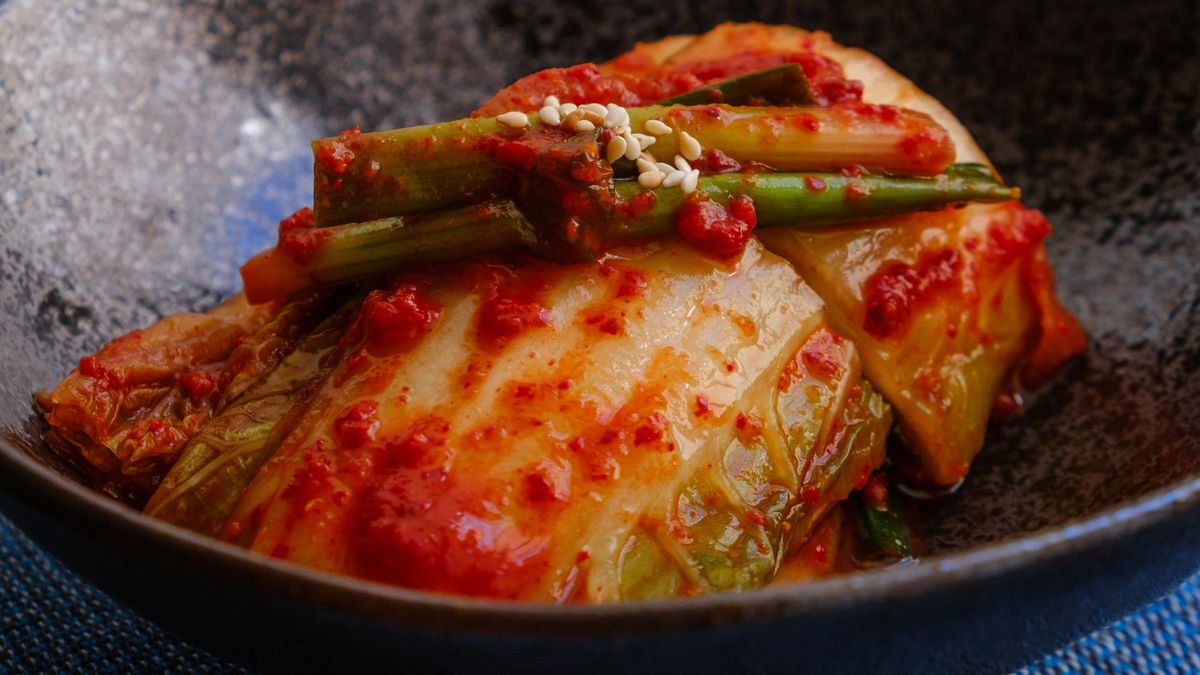JAKARTA - For Koreans, kimchi is a form of identity. Kimchi is the most famous food on the Korean Peninsula. Its sour and spicy taste has always been present in Korean dining events since a long time ago. It's hard to imagine a Korean person without kimchi. Once Kimchi is scarce on the market, the economic turmoil will come to Korea. Because, Kimchi is not just healthy food. Kimchi is an invaluable cultural heritage.
Historically, food made from fermented vegetables has been present in Korea more than three thousand years ago. Kimchi is also said to have existed since the founding of three major kingdoms in Korea: Goguryeo, Baekje and Silla.
At that time, Koreans were fond of preserving food for winter supplies. Then came the idea of using salt in preserving food and vegetables so that they could survive the winter.
However, the vegetable form of kimchi is not yet dominated by red. Kimchi is still known for its golden yellow vegetable form. Quoted from Robert Ji-Song Ku in the book Dubious Gastronomy: The Cultural Politics of Eating Asian in the USA (2014), he said that it was none other than because chilies, which are characteristic of contemporary kimchi, have not yet entered Korea. Therefore, the main ingredients of kimchi are still black pepper, garlic, ginger, and spices that have a sharp aroma.
"It is generally accepted that chilies entered Korea via Japan, sometime after Hideyoshi's attacks in the late 16th century. Chili is the earliest mentioned in Korean documents in 1613. The document calls chilies a 'highly poisonous vegetable.' However, over time the Korean people began to like the spicy taste. The document also states that foods that contain chili are mostly home food including kimchi, "said Robert.
The presence of chilies in kimchi-making gives rise to a label: kimchi is Korean food. Chili peppers have also become an important component in other Korean dishes. Over time, kimchi has many variations and types. Noted, until now kimchi has hundreds of variations. Even so, the taste of each kimchi variation is different. People generally only know kimchi that is spicy and not too spicy.
More completely, a nutritionist from Busan National University, Kun Young-Park revealed that kimchi can be categorized into two major groups. First, kimchi which is usually added with water. Second, kimchi that doesn't add water.
Kimchi that doesn't add water is a kind of dry kimchi consisting of baechu kimchi, kaktugi kimchi, chongkak kimchi, and yeolmoo kimchi. Kimchi without added water tastes saltier, more sour, and spicier. Kimchi added with water is usually called mool kimchi which consists of both kimchi and dongchimi kimchi. The taste of kimchi added with water is more moderate with salty, sour, and spicy flavors in the medium category.
“A traditional Korean dish is incomplete without kimchi, a mixture of various pickled vegetables such as chicory, radish, green onions and cucumber. There are certain kimchi that are made spicy with the addition of red chili powder, while other kimchi are not topped with red chilies or soaked in delicious liquid. But whatever the kimchi, to give it a rich taste there must be garlic, ”writes the book Korea: Past & Present, published by the Information Service and Culture of South Korea in 2012.
South Korea's source of profit
Kimchi has been increasingly recognized by the world since the 1990s. At that time, the South Korean entertainment industry was so popular. The culture, food and entertainment industry of South Korea then invaded the world, including Indonesia. This term is known as the "Korean wave." In more detail, we have reviewed the Korean wave in the article "Historical Roots of Korean Drama: Invasion of Classical Mask Theater Stage".
Since then, kimchi has been beautifully wrapped as a mainstay of South Korean travel. As the policymaker had predicted, kimchi brought great profits. As well as being a mainstay in bringing in travelers from abroad. Not to mention, if you count Korean kimchi exports around the world. Which, the value can reach millions of dollars every year.
"Believe it or not, such as fuel prices, fluctuations in the supply of kimchi, can also cause turmoil in the Korean economy. In 2010, there was a kimchi crisis in South Korea. At that time the yield of chicory was not good, plus the price of chili powder increased due to the global crisis. As a result, the price of kimchi jumped dramatically, which in turn increased inflation in South Korea. This almost caused instability in the Korean economy. In order to obtain kimchi, in several cities there have been thefts or hoarding of white cabbage stocks, ”said Junanto Herdiawan in the book Shocking Korea (2013).
Healthy food
The basic ingredients for making kimchi are also recognized as having high nutritious active ingredients. Take for example the components of carotenoids and bioflavonoids which come from chicory, leeks, carrots, and red chili powder.
Faisal Anwar and Ali Khomsan in the book Proper Food for a Healthy Body (2009), said that these two ingredients can actually function as antioxidants that can destroy free radicals. Which, free radicals cause cancer.
Not only that, the capsaicin found in chili powder can inhibit the growth of cancer cells. The same thing is present in gingerol which is in ginger.
These components can inhibit microbial growth and also function as anticancer. Even kimchi was once predicted as a 'superfood' that can prevent people from being infected with the H5N1 virus and the SARS virus.
"One of the results of research from Seoul National University claims that chickens infected with the H5N1 virus, otherwise known as bird flu recover after eating food containing the same bacteria found in kimchi. When the SARS disease broke out in Asia in 2003, many people believed that Kimchi could provide protection against infection, even though there was no scientific evidence to support this opinion, "concluded Wignyanto and Nur Hidayat in the book Bioindustri (2017).
The English, Chinese, Japanese, Arabic, and French versions are automatically generated by the AI. So there may still be inaccuracies in translating, please always see Indonesian as our main language. (system supported by DigitalSiber.id)













